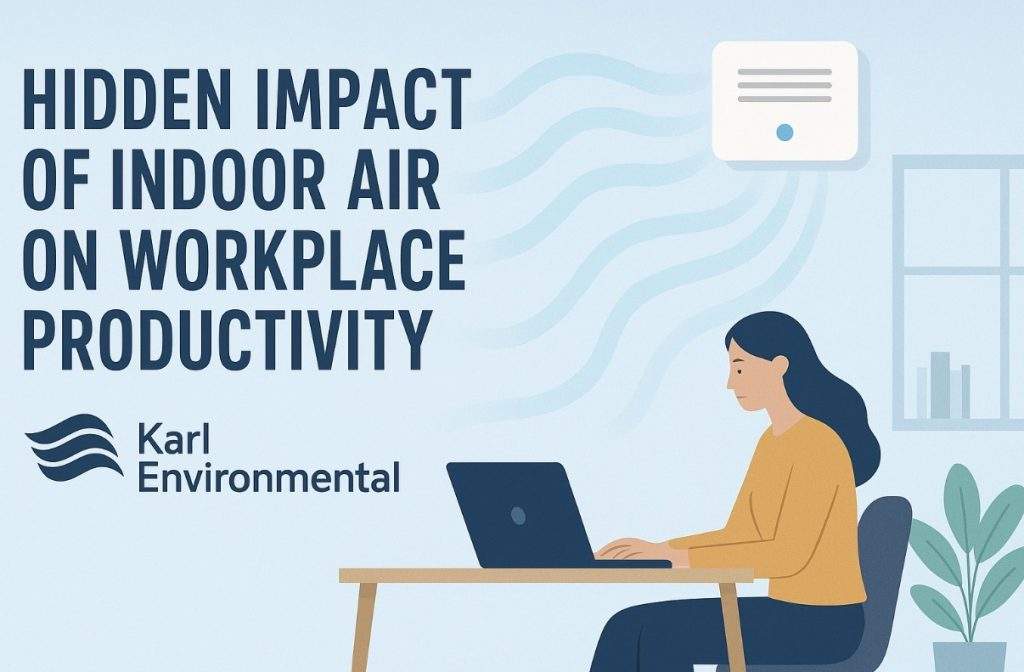When we think about what drives productivity in the workplace, we often focus on motivation, management, and modern technology. But there’s another factor, one that’s invisible, often overlooked, and yet directly tied to how people think, feel, and perform every day: indoor air quality (IAQ).
Why Indoor Air Quality Matters More Than You Think
Most of us spend roughly 90% of our time indoors, whether at the office, a job site, or working from home. The air inside these spaces can be 2 to 5 times more polluted than outdoor air, according to the U.S. Environmental Protection Agency (EPA).
Common indoor pollutants, which include volatile organic compounds (VOCs) from cleaning products or furniture, mold spores, dust, and inadequate ventilation, don’t just affect comfort. They can also have measurable impacts on focus, cognition, and overall productivity.
What the Research Shows
- A growing body of research has confirmed what many facility managers and health experts have long suspected: better air equals better work.
A Harvard School of Public Health study found that employees working in well-ventilated offices with lower CO₂ and VOC levels performed 61% better on cognitive tasks than those in standard environments. - Another study found that improved IAQ reduced employee sick days by up to 35%, saving organizations thousands of dollars per worker each year.
These effects add up. Clearer thinking, fewer headaches, better mood, and stronger immune response all contribute to a more engaged, resilient workforce.
Invisible Factors That Affect Performance
Even modern buildings can have “sick building syndrome” symptoms if air isn’t properly managed. Some of the biggest hidden issues include:
- Inadequate ventilation , especially in energy-efficient buildings that are sealed tight to save energy.
- High CO₂ levels, which can cause fatigue and slow decision-making.
- Chemical off-gassing from paints, carpets, furniture, or cleaning agents.
- Moisture issues that promote mold and bacterial growth.
- Poor filtration or HVAC maintenance, spreading dust, dander, and allergens.
While none of these issues may be visible, their effects often are: increased absenteeism, difficulty concentrating, irritability, and a general sense of fatigue that drags down productivity.
How Businesses Can Take Action
Improving IAQ doesn’t necessarily require a major renovation or costly overhaul. In many cases, small, targeted steps can make a measurable difference.
1. Conduct a professional air quality assessment.
An indoor air quality audit, like those performed by Karl Environmental, can identify hidden contaminants, moisture issues, or ventilation gaps before they become costly problems.
2. Maintain and upgrade HVAC systems.
Regular filter replacement, cleaning of ducts, and ensuring proper ventilation rates help maintain healthy air.
3. Use low-emission materials and products.
Opt for low-VOC paints, sealants, and furnishings to minimize chemical exposure.
4. Monitor humidity and temperature.
Balanced indoor conditions (typically 40–60% humidity) reduce both microbial growth and airborne irritants.
5. Educate employees.
Teaching staff about simple steps, like avoiding strong fragrances or reporting leaks, contributes to a cleaner indoor environment.
The Bottom Line
Indoor air quality is no longer just a “comfort issue.” It’s a business performance issue. Employers who invest in healthy workplaces see real returns through improved productivity, reduced absenteeism, and a stronger company culture that values well-being.
At Karl Environmental, we help businesses identify and resolve hidden air quality challenges so their teams can breathe easier and work smarter. From comprehensive IAQ assessments to remediation planning and ongoing monitoring, our experts deliver solutions that support both health and performance.

